Life with the Lenovo Yoga 2 Pro
by Brett Howse on July 30, 2014 2:00 PM EST- Posted in
- Notebooks
- Lenovo
- Windows 8.1
- Yoga
Design & Chassis
The Yoga 2 Pro continues with the design philosophy of other Lenovo Ultrabooks like the U300s. Rather than imitate a MacBook Air and taper to a thin edge, the styling when closed is more like that of a closed book. The shell of the device is entirely soft touch plastic, including on the bottom. The front lip has an edge with a rubberized coating, which is used as a grip to prevent the device from sliding around when opened up to extreme angles and used in tent mode. The soft touch plastic continues to the interior, where it surrounds the island style backlit keyboard.
The chassis is solid, but the lid has some flex to it. The 0.61" (15.5 mm) frame feels thin but solid, and the 3.06 lb weight is suitable for carrying in a bag. There are only two USB ports, with only one of them being USB 3.0. The 2.0 port can be powered when the device is off to allow charging a smartphone or other device. Lenovo has offered the Yoga 2 Pro in both grey and a vibrant “Clementine Orange”.
Moving from the Alienware, using the Yoga 2 Pro as a laptop is an experience. The keyboard has good travel for a thin device, and the keys have an aural indicator (which I like). The trackpad measures 3.5” x 2.25” (90mm x 57mm) and comes across as quite smooth. As seems to be the standard these days, the trackpad is a clickpad, with no discrete left and right click buttons. While I prefer dedicated left and right buttons on the trackpad, I do see the tradeoff of a clickpad to allow a larger area for the trackpad.
The trackpad supports all of the Windows 8 gestures for charms and app switching, among others. I found these to be a big distraction though, as often when I was typing my palm would brush the trackpad and I would switch to another app. The palm rejection could use some work, but if I disabled all of the gestures I was much happier. In my opinion, they are not really necessary. I have never been a huge fan of trackpads and due to my usage model, I have always preferred the track point available on the ThinkPad lines, or preferably, a real mouse.
The key point of the device is the hinge, which allows the screen to open a full 360° to make the device into a tablet. As I alluded to earlier, we bought this device first and foremost as a laptop. I did not really expect the hinge to be a big deal. I was wrong.
With a touchscreen and Windows 8.1, this device (as you should expect) is just as happy running desktop applications as it is in the modern world of Windows 8.1. For as much as Windows 8 has caused controversy in the computing world, a form factor like this is what I would imagine Microsoft's original plan migrated towards. You can easily switch from laptop to stand mode, and use it completely as a consumption device. If you need to send an email, switch it back, and you’ve got a full keyboard. It is funny how something so simple as being able to open a laptop wider can completely change the way you use it, but that’s the case with the Yoga 2 Pro
Laptop Mode
As a laptop, the Yoga is a device to get things done on the move. It feels as if there is no compromise, unlike some of the other two-in-one devices with a removable keyboard, which can be top heavy since the internals of the laptop are in the screen. Since the internals are still in the keyboard portion of the chassis, it feels and behaves like any other laptop.
Tent Mode
By folding the device like an upside down V, the user can implement tent mode. If the user wanted to do any sort of touch mode activities, tent mode is great because with the rubberized front edge and the V shape the device is extremely sturdy. Pecking at the screen in this mode has no bounce. If you have a flat surface and want to play a touch game, this mode is the best.
Tablet Mode
When I bought the Yoga 2 Pro, I thought it would be nice to be able to use the laptop as a tablet in a pinch, but, like most preconceptions, I was wrong. It can be used as a tablet like this, but the 13.3" screen and 3 lbs of weight can make it unwieldy. The Surface Pro 3 is almost half the weight as a comparison. Furthermore, in this mode the keyboard is tucked underneath, so it is not very comfortable to hold due to your fingers resting on the keys (which thankfully are deactivated when the screen pivots past a certain point). Unless the user is walking around carrying the Yoga, there is almost no reason to ever use it like this. There is one other potential usage scenario for this mode, in that some airlines are now allowing tablets to be used during take off and landing, allowing business travellers to continue working rather than having 20 minutes of downtime.
Stand Mode
For me, stand mode is actually the one mode that changes my paradigm for tablet use. The tablet world has been pushing for lighter devices with smaller screens in order to make it easier to hold them for long periods of time. However my experience has been that the Yoga 2 Pro in Stand Mode is much better for most of what I ever do with a tablet.
This mode makes media consumption great, moreso than a tablet with a cover that doubles as a stand. Folding the keyboard underneath makes for an extremely sturdy base, and the screen can be positioned at any angle that works best for the user. If you have ever tried to watch something in bed on a laptop, the keyboard sits between you and the screen, so it sits farther away. With a tablet, it needs to be held. The ingenious (but in hindsight obvious) solution of an extended range hinge means the user can keep the screen close, have a much larger screen, and not have to hold the device. Though I haven’t had the *cough* pleasure *cough* of flying with it yet, it seems like a good sized device for a cramped economy class seat. Stand Mode makes you rethink how to use a hybrid PC.
 Yoga 2 Pro (left) versus Toshiba Satellite Radius (right)
Yoga 2 Pro (left) versus Toshiba Satellite Radius (right)
For those not sold on the hinge, there is clearly a demand. Since the launch of the Yoga series, several other laptop OEMs have introduced a device with a similar hinge.


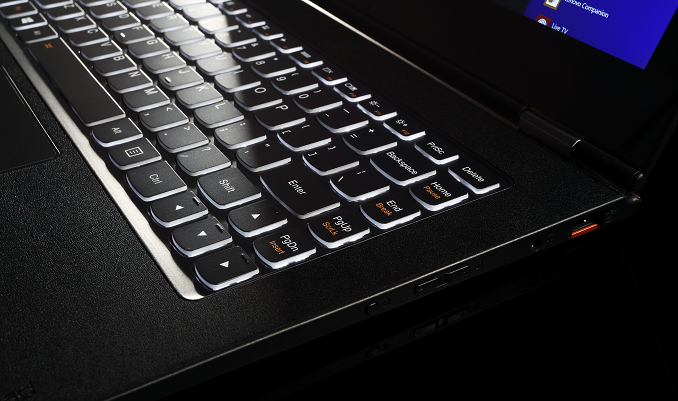
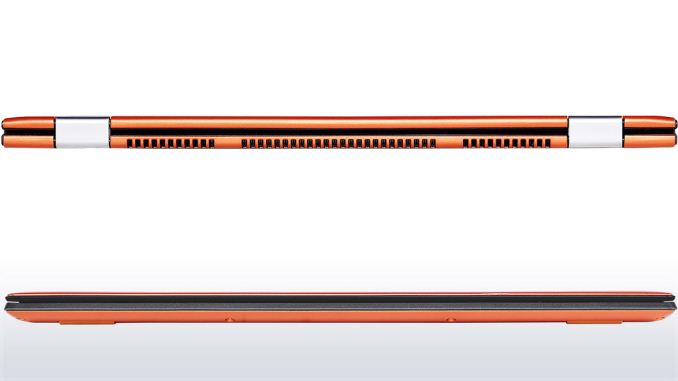
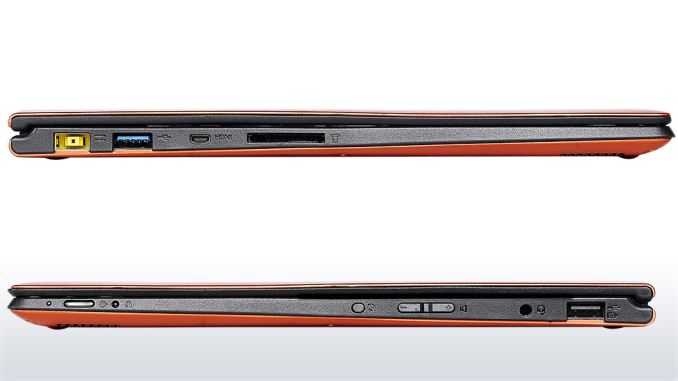
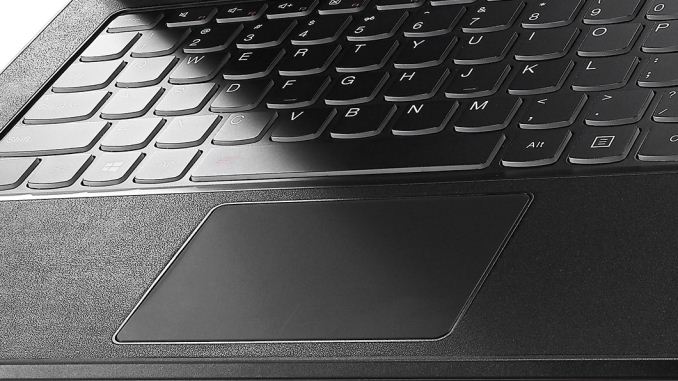
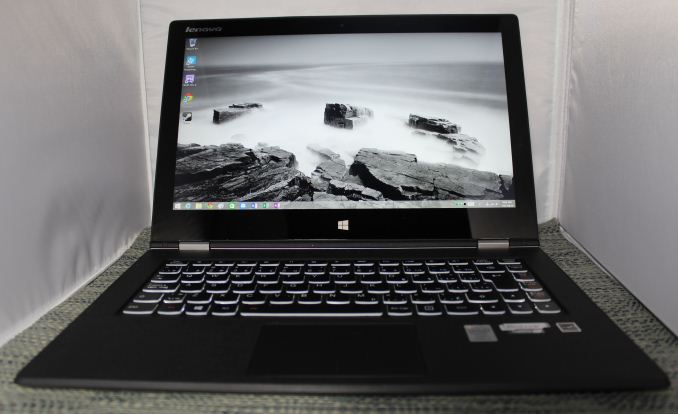
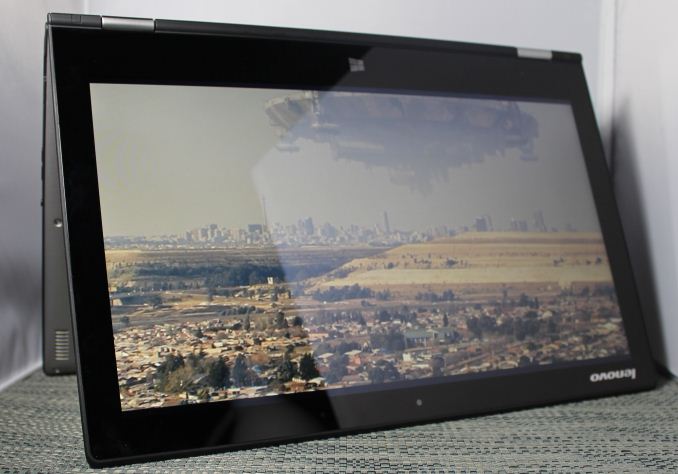
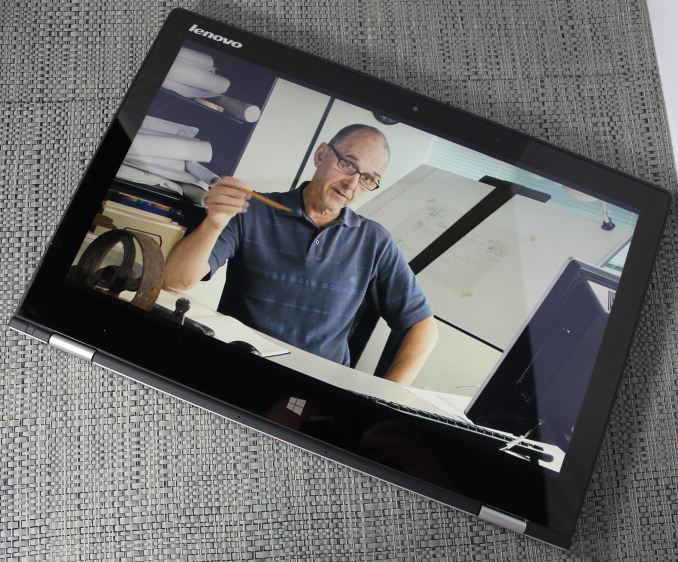
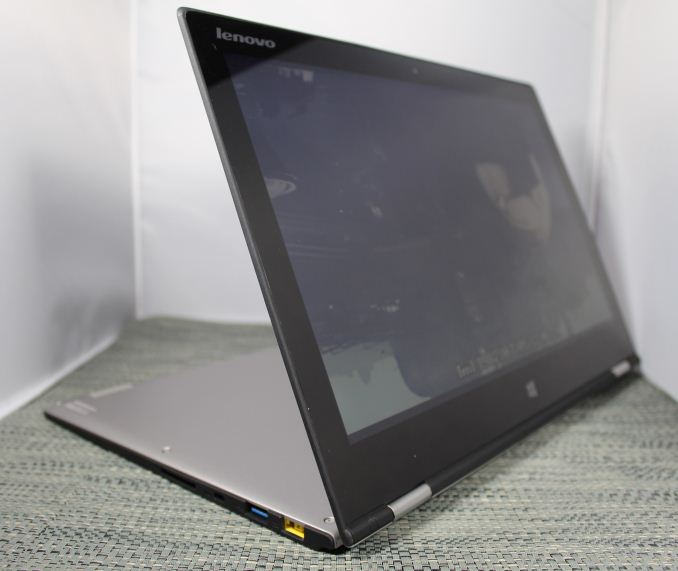








103 Comments
View All Comments
BMNify - Friday, August 1, 2014 - link
Only sub-pixel density matters to your eyes.Rdmkr - Friday, August 1, 2014 - link
"Only sub-pixel density matters to your eyes." - I disagree. Luminance detail is what matters most to the eyes and this is determined by the pixel density, not subpixel density. See http://en.wikipedia.org/wiki/Chrominance#mediaview... ; first is luminance, second chrominance.kyuu - Thursday, July 31, 2014 - link
I wish they made the 11.6" model with a 1080p IPS screen. Everything is great about it except for that damn screen. And the HDD, but I'm hoping that's replaceable (or can at least accept an M.2 like the 13" models can).And I'd prefer some AMD silicon in there, but that's just wishful thinking.
Valantar - Thursday, July 31, 2014 - link
Thanks for a great review - although others have commented on it being late, I find it interesting to get a full review with the added benefit of commentary from actual long-time usage of the device.However, I'm missing some thoughts on using this as more of a work machine rather than a consumption device, especially for more demanding tasks such as video editing. Do you have any additional thoughts here?
What kind of performance delta could one expect between this and the i7 version? In many reviews the difference in performance even between ULV Haswell i5/i7 systems and more powerful chips like the 28W versions in the MBPr 13" seems negligible (3-400 points in PCMark 7). However I'm left wondering if these tests don't tax the systems over a long enough time, so that any differences due to throttling (or inability to sustain turbo speeds) might be hiddden. Could this be the case? I'd imagine near identical performance from these systems due to both being 2C/4T with similar Turbo speeds, but the nearly 1GHz difference in stock speeds should lead to a significant difference under sustained loads, no?
The reason I'm interested in these use cases is that my fiancee needs a new laptop. She's studying filmmaking, so she wants something that would be able to run Avid Media Composer, but still is thin and light enough to carry to school every day. The calibration issues with the display don't matter as we have a professional level external monitor at home, and any really heavy work would be done on a desktop. I know the system requirements for Media Composer state that a quad core processor is required, but this would exclude the MBPr 13" as well, so I'm taking this with a grain of salt. My question is in essence this: is there any reason why the Yoga 2 Pro (i7) would not be a good fit for this kind of usage?
Brett Howse - Thursday, July 31, 2014 - link
Hi Valantar. While I haven't specifically tested the software you listed so I can't comment on how well it would run, in the benchmarks I specifically made sure to include other similar sized machines. The one closest to what you are asking about is the Acer Aspire V7-482PG-9884 (by the way I love that model name). It's got the 15 watt Haswell i7-4500U so it should be a close comparison as far as CPU performance. The GPU side is different of course because it has a GeForce GT 750M, but on the CPU benchmarks it should be fairly accurate.The performance difference isn't huge, because they are both dual core, four thread CPUs with the i5 having a base clock of 1.6 GHz and ramping to 2.6 GHz, with the i7 base at 1.8 GHz ramping to 3.0 GHz. The i7 certainly has an advantage but it's not a lot, so if you are talking about a 15 watt part, the performance is similar, but clearly lower for the i5.
Valantar - Friday, August 1, 2014 - link
Thanks for the clarification! I'm still interested in how this would compare to 28W Haswell, but I can see that AnandTech hasn't reviewed a MBPr since 2012, so I guess I'll have to look around a bit for the answer to that.As an owner of the device, how would you rate it when it comes to heavier tasks? Does it feel quick when, for example, editing a video or photos? Or would you say it's mostly suited for lighter/more consumption-oriented tasks?
CSMR - Thursday, July 31, 2014 - link
Quadrupling resolution is stupid. I wish the PC market would stop doing this.There is an optimal resolution for a screen size. Too low resolution and things do not look sharp. Too high resolution and there is needless extra cost, gpu draw and power, and incompatibility with normal resolutions for multi-monitor setups (even using an standard external screen some of the time becomes impossible).
For a 13" screen, 768p is terrible, 900p good, 1080p excellent, beyond 1080p too high.
If Windows ever becomes fully resolution-independent, then ultra-high-res becomes OK, but that requires architecture changes for working with more than one screen resolution simultaneously.
deejayshakur - Thursday, July 31, 2014 - link
Nice review on the Y2P. I came across many similar reviews discussing the high dpi, wireless card, and yellow display as being weaknesses. So I cross-shopped the Acer S7 (disliked the key configuration on a previous acer), Yoga 2 13", XPS 12 and 15, Macbook Air and ended up scoring a Yoga 2 13" in a sweet configuration from BB: i5-4210U, 8 GB of RAM, Intel 7260 AC wireless, and a 128 GB Samsung XP941 M.2 SSD (which I had no idea about until I brought the machine home). For those that don't know, the Yoga2 (non-pro) comes with the standard 1080p screen (I decided against the Y2P screen). The tradeoff with the Yoga2 is 0.5 lb. Oh, and BB had it on an .edu discount, so $899-125-10% USPS moving discount = $675 and tax.Initial thoughts: blazing fast machine for everyday tasks. Great 7-9ish hour battery life on power saver mode. PC Mark 7 basic score was 4953. Boots in 5 seconds, and wakes from hibernation in 8-10 seconds. No wifi issues so far (still in a 802.11g household). The touchpad seems to have a coating on it as everything wipes off nicely and feels soft-touch like the rest of the palm rest area.
Expansion-wise: I popped a 64 GB Transcend Jetdrive into the SDXC slot. On the Lenovo forums, people have identified an extra, internal M.2 connector, so when those drives become mainstream, there's room for more.
Most of the reviews for the Yoga 2 13 are based on a 4 GB of ram and a non-SSD. I'm glad Lenovo came out with this configuration cause for most users, I think it's the best of all worlds.
Mayuyu - Friday, August 1, 2014 - link
I got the exact same laptop and exact same deal along with Best Buy 10% rewards. The XP941 SSD was certainly a surprise. My only disappointments was the pentile screen and the inability to increase the TDP in Intel extreme tuning utility.FwFred - Thursday, July 31, 2014 - link
I can confirm I've been using the 7260 AC with no issue since last November. The replacement is fairly cheap, but it was hard to find someone selling the proper version. The swap was pretty easy except for re-attaching the antenna leads. If my fingers were about 10% of their actual size, I think it would be about right :-/